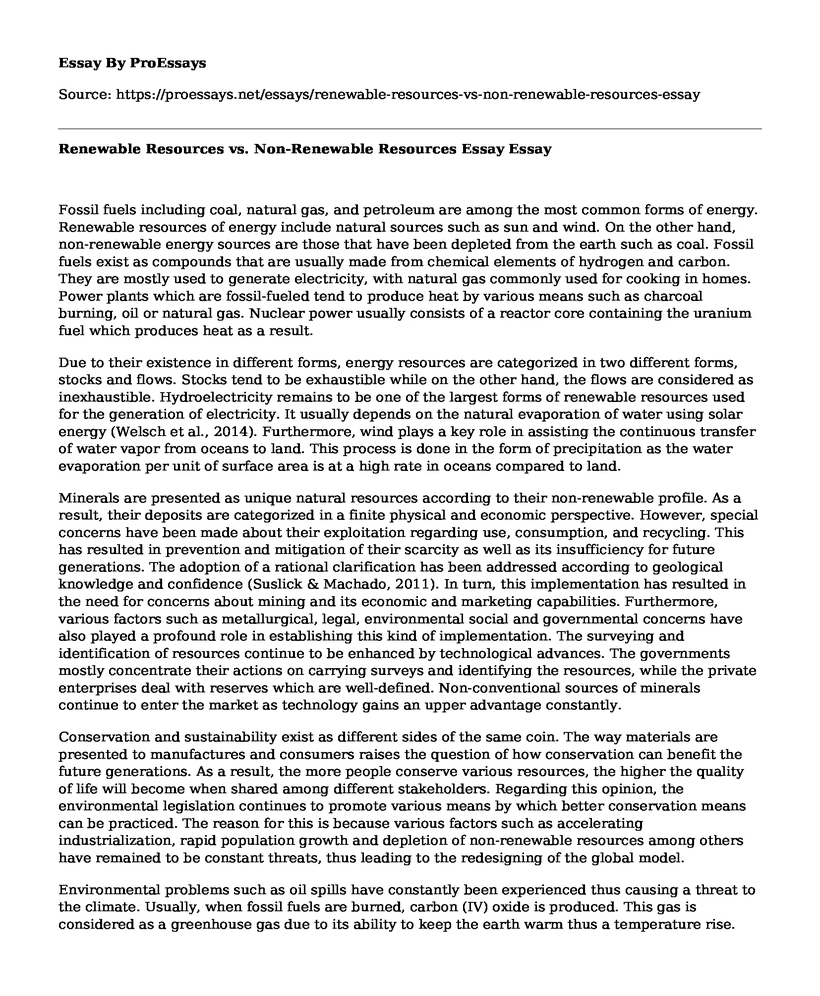Fossil fuels including coal, natural gas, and petroleum are among the most common forms of energy. Renewable resources of energy include natural sources such as sun and wind. On the other hand, non-renewable energy sources are those that have been depleted from the earth such as coal. Fossil fuels exist as compounds that are usually made from chemical elements of hydrogen and carbon. They are mostly used to generate electricity, with natural gas commonly used for cooking in homes. Power plants which are fossil-fueled tend to produce heat by various means such as charcoal burning, oil or natural gas. Nuclear power usually consists of a reactor core containing the uranium fuel which produces heat as a result.
Due to their existence in different forms, energy resources are categorized in two different forms, stocks and flows. Stocks tend to be exhaustible while on the other hand, the flows are considered as inexhaustible. Hydroelectricity remains to be one of the largest forms of renewable resources used for the generation of electricity. It usually depends on the natural evaporation of water using solar energy (Welsch et al., 2014). Furthermore, wind plays a key role in assisting the continuous transfer of water vapor from oceans to land. This process is done in the form of precipitation as the water evaporation per unit of surface area is at a high rate in oceans compared to land.
Minerals are presented as unique natural resources according to their non-renewable profile. As a result, their deposits are categorized in a finite physical and economic perspective. However, special concerns have been made about their exploitation regarding use, consumption, and recycling. This has resulted in prevention and mitigation of their scarcity as well as its insufficiency for future generations. The adoption of a rational clarification has been addressed according to geological knowledge and confidence (Suslick & Machado, 2011). In turn, this implementation has resulted in the need for concerns about mining and its economic and marketing capabilities. Furthermore, various factors such as metallurgical, legal, environmental social and governmental concerns have also played a profound role in establishing this kind of implementation. The surveying and identification of resources continue to be enhanced by technological advances. The governments mostly concentrate their actions on carrying surveys and identifying the resources, while the private enterprises deal with reserves which are well-defined. Non-conventional sources of minerals continue to enter the market as technology gains an upper advantage constantly.
Conservation and sustainability exist as different sides of the same coin. The way materials are presented to manufactures and consumers raises the question of how conservation can benefit the future generations. As a result, the more people conserve various resources, the higher the quality of life will become when shared among different stakeholders. Regarding this opinion, the environmental legislation continues to promote various means by which better conservation means can be practiced. The reason for this is because various factors such as accelerating industrialization, rapid population growth and depletion of non-renewable resources among others have remained to be constant threats, thus leading to the redesigning of the global model.
Environmental problems such as oil spills have constantly been experienced thus causing a threat to the climate. Usually, when fossil fuels are burned, carbon (IV) oxide is produced. This gas is considered as a greenhouse gas due to its ability to keep the earth warm thus a temperature rise. However, with energy being a vital source of life, various practices are constantly carried out to assure that clean and non-harmful energy is used. For instance, the use of non-renewable resources as alternative energy sources has widely been encouraged due to their non-depletion capabilities.
References
Suslick, S. B., & Machado, I. F. (2011). Nonrenewable Resources. Earth System: History and Natural Variability, 1.
Welsch, M., Deane, P., Howells, M., Gallachoir, B. O., Rogan, F., Bazilian, M., & Rogner, H. H. (2014). Incorporating flexibility requirements into long-term energy system models-A case study on high levels of renewable electricity penetration in Ireland. Applied Energy, 135, 600-615.
Cite this page
Renewable Resources vs. Non-Renewable Resources Essay. (2022, May 09). Retrieved from https://proessays.net/essays/renewable-resources-vs-non-renewable-resources-essay
If you are the original author of this essay and no longer wish to have it published on the ProEssays website, please click below to request its removal:
- Research Paper on Dealing With Climate Changes and Global Warming
- Environmental Problems in Ecuador's Primary Rainforest Essay
- Essay Example on Great Barrier Reef: Challenges and Solutions for Climate Change
- Essay Example on Singapore's Solarisation: Public Housing, Floating Solar & More
- Paper Sample on Meat Production: Feed-Lots vs. Grass-Fed - Ecological vs. Unnatural
- Paper Example: Ensuring Risk Mitigation During Earthquakes in Sentinel City
- Disaster Preparedness - Free Report Sample







